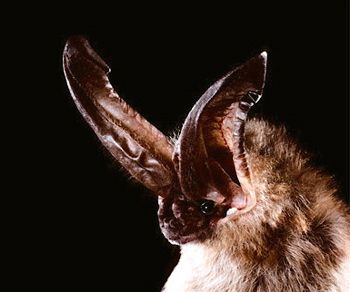 Pictured at left is a Virginia big-eared bat.
Pictured at left is a Virginia big-eared bat.Last June, I wrote about White Nose Syndrome (WNS), a disease of cave-dwelling bats in the northeastern United States. Bats with WNS awake from hibernation frequently and fail to maintain enough body fat to survive the winter. The starving WNS bats have white fungus on their muzzles. The previously-uncharacterized Geomyces fungus species associated with WNS has now been named Geomyces destructans, but it remains unclear whether the bats have an underlying immune deficiency that renders them susceptible to fungal infection.
One of the species affected by WNS is the endangered Virginia big-eared bat. Five thousand of the remaining Virginia big-eared bats live in West Virginia's Hellhole cave, which is now affected by WNS. Last week, Wired Science reported that a desperate attempt to preserve the species by establishing a breeding colony in captivity is not going well. Brandon Keim writes,
A fierce attempt to keep endangered Virginia big-eared bats alive in captivity has shown just how difficult that noble task may be.
The effort was prompted by the discovery of white nose syndrome, an extremely virulent disease that has killed more than a million bats since 2007, in one of the handful of caves where Virginia big-eared bats live. Of 40 bats moved to the Smithsonian National Zoo last November, only 11 have survived.
“We were not under the illusion that it was going to be easy. It’s certainly not a surprise to us that the bats died. But the number of bats that died is greater than we had hoped,” said Jeremy Coleman, white nose syndrome coordinator at the U.S. Fish and Wildlife Service.
[snip]
Unlike fruit-eating bats, insect-eating bats like the Virginia big-eared are notoriously difficult to raise in captivity. Accustomed to catching insects on the wing, many of the bats refused to eat worms from pans. Stressed from relocation and habituated to cave-specific temperatures and humidity, others developed runaway bacterial infections. Despite constant attention from researchers, 29 of the bats died.
The surviving 11 big-eared bats may yet breed, so here's wishing them luck. It might be too late for this species.
Another development in WNS work is more encouraging. The journal Science reports that Geomyces destructans has been found in healthy European bats. In "Europe's Bats Resist Fungal Scourge of North America", Erik Stokstad reports that
The same fungus that has devastated bat colonies in the northeastern United States has been identified for the first time in Europe—in a healthy bat. "The astonishing thing is that [the fungus] affects North American bats so devastatingly, but that European bats can get along with it," says Christian Voigt, a bat physiologist at the Leibniz Institute for Zoo and Wildlife Research (IZW) in Berlin.
[snip]
On 12 March, Sébastien Puechmaille of University College Dublin (UCD) spotted a mouse-eared bat (Myotis myotis) covered with fungus in a cave 130 kilometers northeast of Bordeaux, France. Microscopic examination of the spores and two molecular markers showed that it was G. destructans, the team reported online 29 December in Emerging Infectious Diseases. Another group, led by Gudrun Wibbelt of IZW, has also identified the fungus in bats from three other European countries, none reporting bat deaths. Their results have been submitted to the same journal.
Now the challenge is to figure out why most European bats are not infected and why those that are remain healthy—and whether that knowledge can be used to help ailing bat populations in the United States. One scenario is that G. destructans has been present in Europe for a long time, and European bat species have evolved immunity, says Emma Teeling of UCD, the senior author of the December paper. Or perhaps the fungus evolved greater virulence after arriving in North America, a possibility that could be investigated with further sequencing.
It's going to take much work and luck, but I hope that more information about the natural history of G. destructans infection in European bats leads to prevention or treatment for threatened U.S. bat populations.




Shakesville is run as a safe space. First-time commenters: Please read Shakesville's Commenting Policy and Feminism 101 Section before commenting. We also do lots of in-thread moderation, so we ask that everyone read the entirety of any thread before commenting, to ensure compliance with any in-thread moderation. Thank you.
blog comments powered by Disqus